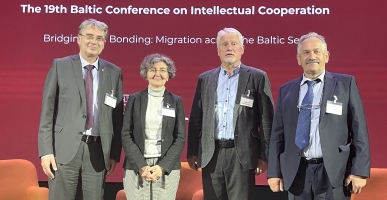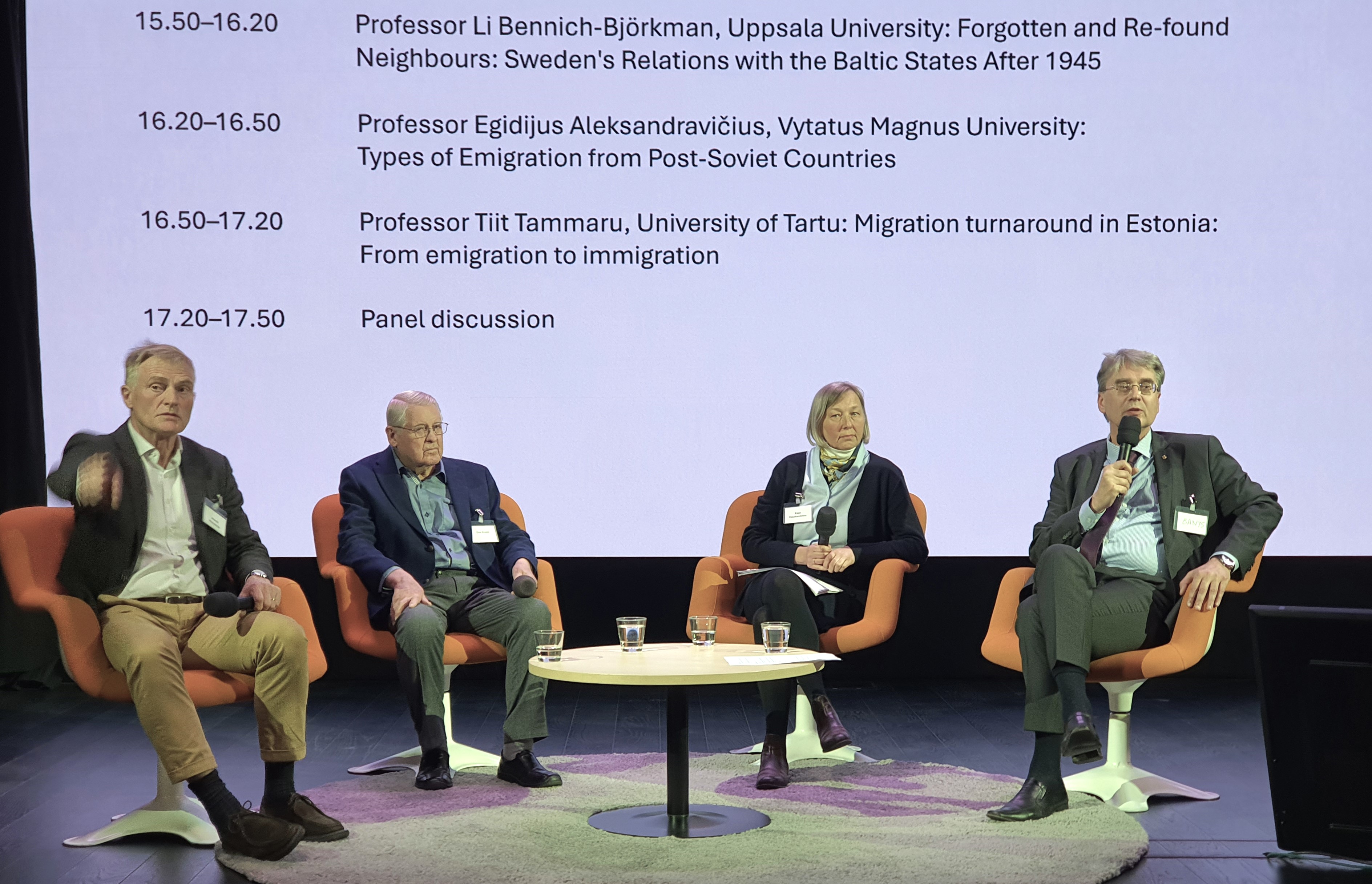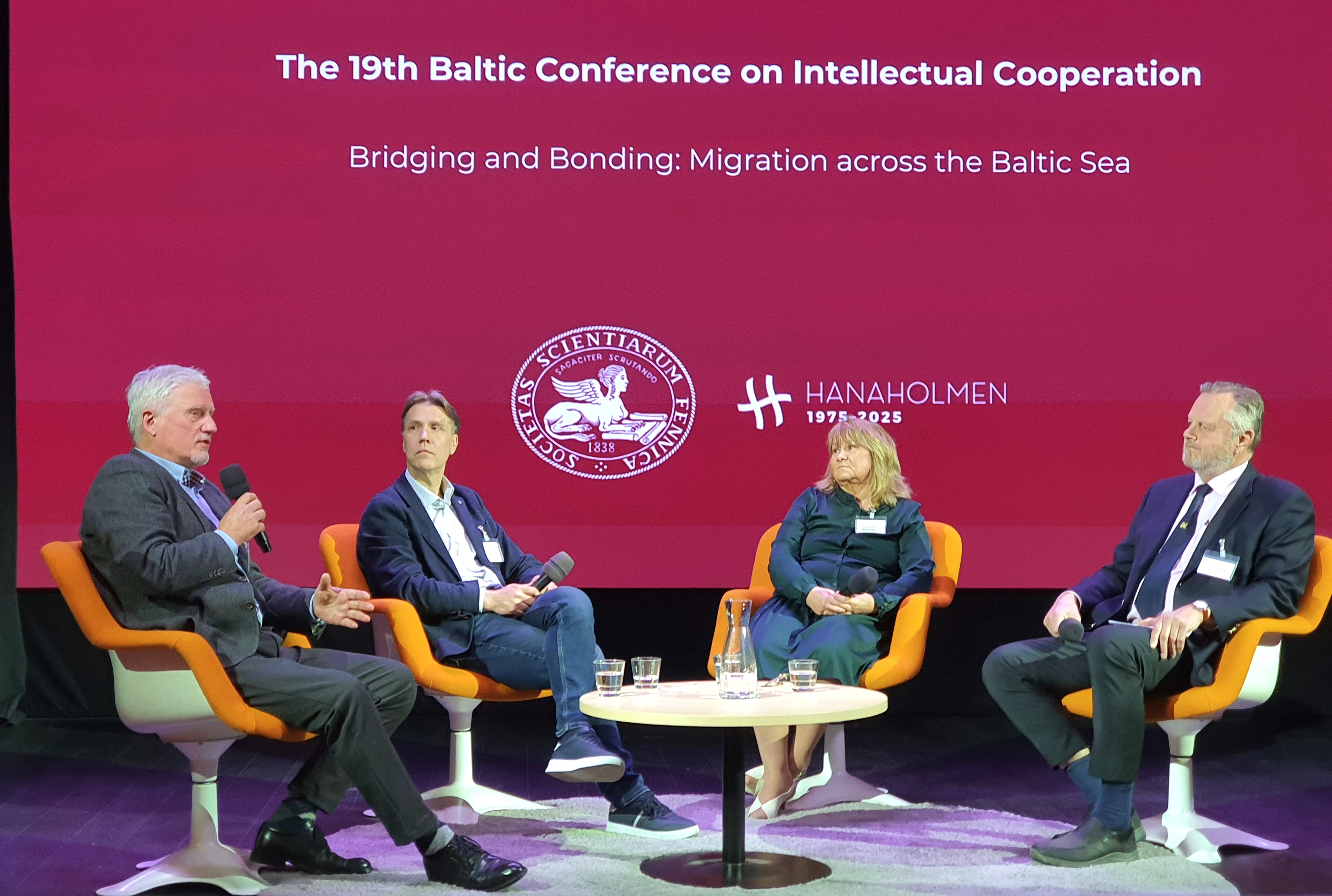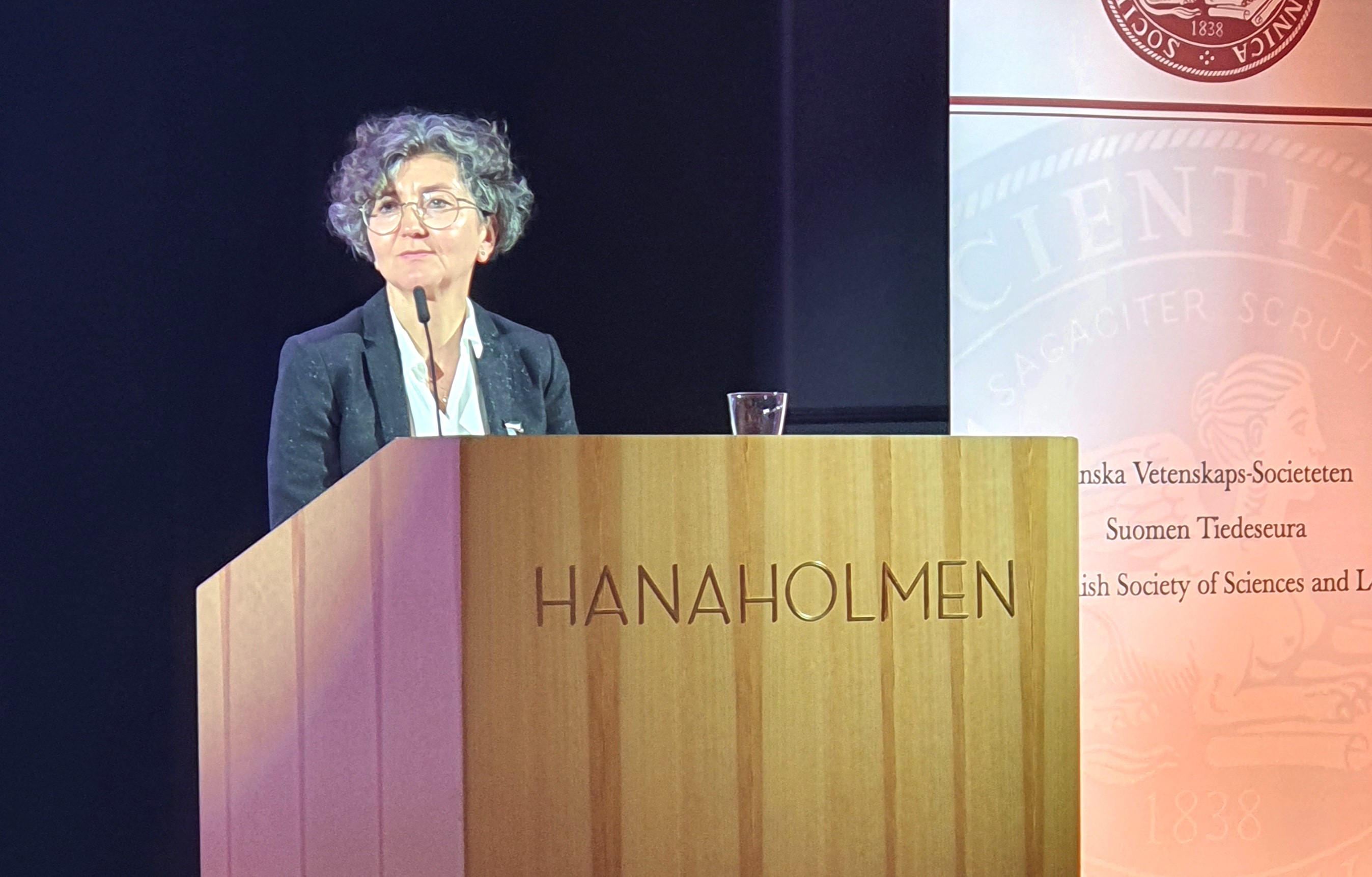Events
The 19th Baltic Intellectual Cooperation Conference: Focus on Migration in the Baltic Countries
22 05 2025
The 19th Baltic Intellectual Cooperation Conference Bridging and Bonding: Migration across the Baltic Sea took place on 13-14 May 2025 at the Finnish Society of Sciences and Letters in Helsinki. The conference aimed to bring scholars from several academic societies around the Baltic Sea together to discuss the topic of migration past and present.
The Baltic Sea has been a highway for commerce and migration ever since people have settled in this region. It was also a battlefield between states and empires. Migration has been a constant phenomenon, especially during the Second World War and in the twenty-first century. The openness before the Second World War was followed by a period of closeness during the Cold War, then replaced by renewed openness until 2015, when a new phase of voluntary closeness began.
Representatives of Finnish, Estonian, Latvian, and Lithuanian academies of sciences, as well as members of academic communities, actively participated in this conference. Lithuania was represented by Prof. Jūras Banys, President of the Lithuanian Academy of Sciences, Prof. Zenonas Dabkevičius, Vice President, Prof. Aušra Maslauskaitė, and Prof. Egidijus Aleksandravičius, both full members of the Academy.
In his welcome address, Prof. Jan Sundberg, chair of the Finnish Society of Sciences and Letters, pointed out that the problems of population migration are a topical issue all over the modern world, including in Baltic countries. In the past, the Baltic populations migrated to the West, now they re-emigrate to the Baltic countries. From the South, migrants arrive in Scandinavia, mainly via Denmark, and in Finland via the Gulf of Finland. Hence, this phenomenon has its advantages and disadvantages that need to be addressed. Victor Andersson, Programme Director at Hanaholmen the Swedish-Finnish Cultural Centre, welcomed the participants and pointed out that migration issues need to be tackled jointly by sociologists, scientists, politicians, and authorities.
The first session of the conference, Migration and Geopolitical Change, was moderated by Prof. Jūras Banys, president of the Lithuanian Academy of Sciences. This part of the conference focused on the migration of Estonians, Estonian Swedes and Finns during the Second World War.
Dr Kaja Haukanomm from the University of Tartu pointed out that about 80,000 Estonians left the country during the Second World War: 50,000 fled to Germany, 25,000 to Sweden, 1100 to Denmark, 1500 to Austria, also to Finland and Poland. There were even plans to evacuate the University of Tartu to Germany or Sweden, but they did not materialise. After the war, around 21,000 Estonians were repatriated from other countries. Ove Knekt, chair of the Estonian Swedish Association, reminded the audience that before the Second World War, there was a large diaspora of Swedes living on the coast and islands of Estonia, who emigrated first to Sweden and other Western European countries and are now united by the association. Prof. Henrik Mainander, University of Helsinki, spoke of Finnish migration between 1939 and 1945. He pointed out that around 700,000 Finns emigrated from Finland (mainly from Karelia – 430,000) and over 550,000 Soviet citizens immigrated into the country. The most painful fact is that around 80,000 children were deported from Finland to Sweden, most of whom the Swedes did not return to the Finns after the war on the grounds that they had already learnt Swedish and it was safer for them to live in Sweden.
The panel discussion concluded that migration during the Second World War caused irreparable damage to the Baltic countries, because many emigrants did not return due to changes in their lifestyle, languages they had learned, and economic conditions. It would be preferable to ensure that such a situation does not occur again.

The second session, Post-Soviet Era, was opened by Prof. Li Bennich-Björkman (Uppsala University), who gave the presentation ‘Forgotten and Re-found Neighbours: Sweden's Relations with the Baltic States After 1945’. She pointed out that Sweden was pragmatic during the war: German trains were passing through the country in preparation for a German victory, even though Sweden had declared neutrality. In 1946, Swedish Social Democratic government handed migrants, refugees, and Soviet citizens who had been brought by the Germans for labour over to the USSR, where they were shot or exiled to Siberia by the Soviets. In 1989, Swedish Foreign Minister Sten Anderson stated that the Baltic countries had not been occupied and that only few people wanted independence, but after the restoration of independence in the Baltic countries Swedes changed their minds. After the war, before joining NATO, Sweden declared itself a neutral country. A large Estonian diaspora remained in the country and established its own school in Stockholm.
In his presentation ‘Types of Emigration from Post-Soviet Countries’, Prof. Egidijus Aleksandravičius (Vytautas Magnus University) noted that throughout history, about two million Lithuanians emigrated to many countries around the world, including Brazil, Argentina, South Africa, the USA, Canada, and others. Unlike Estonians and Latvians, Lithuanians did not settle in Scandinavian countries before the Second World War. It was only after 1991 that Lithuanians started emigrating to Norway, Sweden, Ireland, and England. At the beginning it was mostly unskilled workers who made up the largest numbers, and later they were followed by medical, IT, and engineering professionals. There are no precise statistics, but it is estimated that around 600,000-800,000 citizens of Lithuania emigrated after 1991. It is encouraging that Lithuania's improved economic situation has led to re-migration that started five years ago. Prof. Tiit Tammaru (University of Tartu) confirmed in his presentation ‘The Migration Turnaround in Estonia: From Emigration to Immigration‘ that similarly to other Baltic countries, the largest wave of emigration from Estonia started after 1990. It is estimated that even now around 50,000 Estonians live in Finland. In Estonia, re-emigration started in 2024, but it is lower than in Lithuania and Latvia. The largest number of the returnees is made up from people born between 1957 and 1967 and those who have families in the country. Estonian Russians are the least likely to emigrate from Finland because there is a financial incentive to stay. At present, the main immigrants to Estonia are Ukrainians and Russians.

In conclusion, the participants welcomed the fact that re-migration had already started and pointed out that the challenge ahead was to integrate new immigrants, especially those from southern countries, into society and the labour market.
The third session EU Membership and Free Border Crossing within Schengen opened with Dr Jessica Gustafsson’s (University of Södertörn) presentation ‘The Connectivity of Post-Migrant Media in the Baltic Sea Region’. She discussed the migrant communities that had emerged in Sweden, Germany, and Estonia and pointed out that Estonia has the largest number of Russian-speaking migrants, while Sweden and Germany have the largest number of migrants from Southern Europe, Asia, and even Africa. This leads to mixtures of Estonian, Russian, Swedish, German, and English. The only solution is for the local residents to communicate with the migrants more and to teach them local languages. Assoc. Prof. Katarina Mattsson (Sodertorn University) and Dr Riikka Taavetti (University of Turku) gave the presentation ‘Cruising the Baltic Sea: Nation, Gender and Sexuality in Pleasure-Based Ferry Traffic between Finland, Åland, and Sweden’. With the launch of the Viking Line and Silja Line in the 1970s, and Queer in 2009, cruise ships in the Baltic Sea developed special pleasure cruises with bathhouses, restaurants, and events promoting drug use and sexual freedom. They attracted crowds of young people, and it was not until the 1983 HIV outbreak that this activity stopped.

Prof. Aušra Maslauskaitė (Vytautas Magnus University) delivered the presentation ‘Demographic Anxiety and Migration in Lithuania’ and shared information on the evolution of the population over the last 63 years. She noted that in 1960, Lithuania had a population of 2.67 million, in 1990 – 3.7 million, and in 2020 about 2.7 million again. It is encouraging that Lithuania's population reached 2.8 million in 2023, due to more people returning from abroad and immigrants. However, rising immigration creates competition for jobs and causes criminal problems that need to be addressed.
Prof. Inta Mierina (University of Latvia) spoke of‘The Consequences of Labour Market Integration in the Nordic-Baltic Region: Beyond the Economic Effects’ in the fourth and final conference session New Barriers against Migration and Asylum. In her presentation, she pointed out that the Nordic countries attract immigrants because of their tolerance, social security, trust in the population as their prosperous economies. Baltic migrants had to adapt to the trust between employer and employee, tolerance and care for one another. In the Baltic countries, labour relations are still based on hierarchical and autocratic management, which stifles workers‘ initiatives. Therefore, the Baltic countries need to adopt the Nordic approach to values and experience: Baltic-Nordic cooperation is the key to Baltic success.
At the end of the conference, the heads of the Finnish, Latvian, and Lithuanian academies of sciences decided that the next Baltic conference on intellectual cooperation will be held in May 2027 at the Lithuanian Academy of Sciences. The proposed theme for the forthcoming conference is ‘Artificial Intelligence and Information Technology’. The conference will seek to attract academies of science from Poland, Hamburg, Sweden, Norway, and Denmark.
Text and photography by Prof. Zenonas Dabkevičius, Vice-President of the Lithuanian Academy of Sciences
Translated by Diana Barnard
